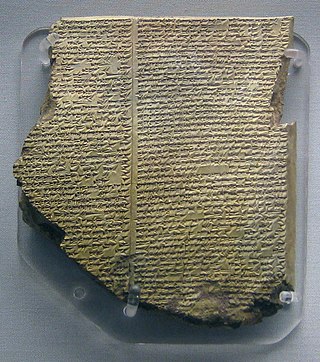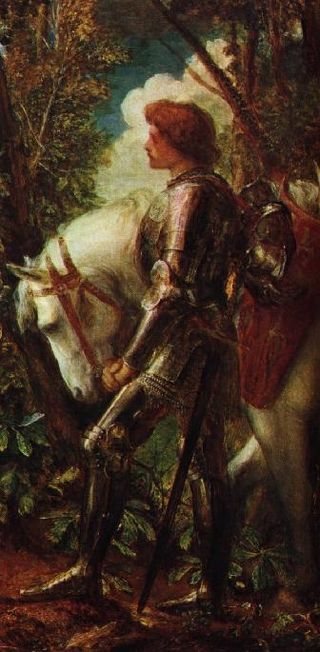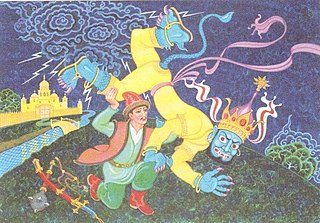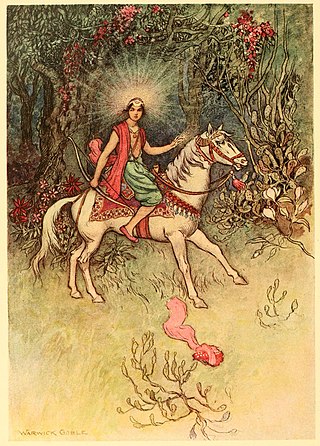
The Epic of Gilgamesh is an epic from ancient Mesopotamia. The literary history of Gilgamesh begins with five Sumerian poems about Gilgamesh, king of Uruk, some of which may date back to the Third Dynasty of Ur. These independent stories were later used as source material for a combined epic in Akkadian. The first surviving version of this combined epic, known as the "Old Babylonian" version, dates back to the 18th century BC and is titled after its incipit, Shūtur eli sharrī. Only a few tablets of it have survived. The later Standard Babylonian version compiled by Sîn-lēqi-unninni dates to somewhere between the 13th to the 10th centuries BC and bears the incipit Sha naqba īmuru. Approximately two-thirds of this longer, twelve-tablet version have been recovered. Some of the best copies were discovered in the library ruins of the 7th-century BC Assyrian king Ashurbanipal.

The Hopi maintain a complex religious and mythological tradition stretching back over centuries. However, it is difficult to definitively state what all Hopis as a group believe. Like the oral traditions of many other societies, Hopi mythology is not always told consistently and each Hopi mesa, or even each village, may have its own version of a particular story, but "in essence the variants of the Hopi myth bear marked similarity to one another." It is also not clear that the stories told to non-Hopis, such as anthropologists and ethnographers, represent genuine Hopi beliefs or are merely stories told to the curious while keeping safe the more sacred Hopi teachings. As folklorist Harold Courlander states, "there is a Hopi reticence about discussing matters that could be considered ritual secrets or religion-oriented traditions."

Galahad, sometimes referred to as Galeas or Galath, among other versions of his name, is a knight of King Arthur's Round Table and one of the three achievers of the Holy Grail in Arthurian legend. He is the illegitimate son of Sir Lancelot du Lac and Lady Elaine of Corbenic and is renowned for his gallantry and purity as the most perfect of all knights. Emerging quite late in the medieval Arthurian tradition, Sir Galahad first appears in the Lancelot–Grail cycle, and his story is taken up in later works, such as the Post-Vulgate Cycle, and Sir Thomas Malory's Le Morte d'Arthur. In Arthurian literature, he replaced Percival as the hero in the quest for the Holy Grail.

Kalevipoeg is a 19th-century epic poem by Friedrich Reinhold Kreutzwald which has since been considered the Estonian national epic.

Väinämöinen is a demigod, hero and the central character in Finnish folklore and the main character in the national epic Kalevala by Elias Lönnrot. Väinämöinen was described as an old and wise man, and he possessed a potent, magical singing voice.

English folklore consists of the myths and legends of England, including the English region's mythical creatures, traditional recipes, urban legends, proverbs, superstitions, and folktales. Its cultural history is rooted in Celtic, Christian, Nordic and Germanic folklore.

The Tale of Tsar Saltan, of His Son the Renowned and Mighty Bogatyr Prince Gvidon Saltanovich and of the Beautiful Swan-Princess is an 1831 fairy tale in verse by Alexander Pushkin.

The "swan maiden" story is a name in folkloristics used to refer to three kinds of stories: those where one of the characters is a bird-maiden, in which she can appear either as a bird or as a woman; those in which one of the elements of the narrative is the theft of the feather-robe belonging to a bird-maiden, though it is not the most important theme in the story; and finally the most commonly referred to motif, and also the most archaic in origin: those stories in which the main theme, among several mixed motifs, is that of a man who finds the bird-maiden bathing and steals her feathered robe, which leads to him becoming married to the bird-maiden. Later, the maiden recovers the robe and flies away, returning to the sky, and the man may seek her again. It is one of the most widely distributed motifs in the world, most probably being many millennia old, and the best known supernatural wife figure in narratives.

The Epic of Koroghlu is a heroic legend prominent in the oral traditions of the Turkic peoples, mainly the Oghuz Turks. The legend typically describes a hero who seeks to avenge a wrong. It was often put to music and played at sporting events as an inspiration to the competing athletes. Koroghlu is the main hero of epic with the same name in Azerbaijani, Turkmen and Turkish as well as some other Turkic languages. The epic tells about the life and heroic deeds of Koroghlu as a hero of the people who struggled against unjust rulers. The epic combines the occasional romance with Robin Hood-like chivalry.
How Ian Dìreach got the Blue Falcon is a Scottish fairy tale, collected by John Francis Campbell in Popular Tales of the West Highlands. He recorded it from a quarryman in Knockderry, Roseneath, named Angus Campbell.

Aqua Knight is a Japanese manga series written and illustrated by Yukito Kishiro. It's a tale about Ruliya, a female orca-riding knight, making an epic journey through the aqueous world of Marmundo.

Hinilawod is an epic poem orally transmitted from early inhabitants of a place called Sulod in central Panay, Philippines. The term "Hinilawod" generally translates to "Tales From The Mouth of The Halawod River". The epic must have been commonly known to the Visayans of Panay before the conquest, since its main protagonists, like Labaw Donggon, were noted in the accounts of the Islanders' beliefs and recorded by early Spanish colonizers. One of these Westerners' accounts says that the adventures of this ancient hero of Panay were recalled during weddings and in songs. It was noted that there were still native Mundos of Dingle, Iloilo who worshipped Labaw Donggon even during the last years of the Spanish rule in the Philippines. These worshippers would stealthily enter a certain cave in Dingle in the evening of a certain day of the year, in order to render homage and to offer chickens, doves, rice, bananas, and pigs to the ancient Visayan god.

Ural-batyr or Oral-batır is the most famous kubair of the Bashkirs. It is a telling of heroic deeds and legendary creatures, the formation of natural phenomena, and so on.
Hainteny is a traditional form of Malagasy oral literature and poetry, involving heavy use of metaphor. It is associated primarily with the Merina people of Madagascar. In its use of metaphor and allusion it resembles another type of poetry, the Malay pantun, and Fox suggests "it seems likely the Merina brought with them a Malayo-Polynesian poetic tradition" to Madagascar. The Ibonia, an epic poem related for centuries in different versions across Madagascar, reflects the value placed on the linguistic skills celebrated in the hainteny tradition, and offers insight into the diverse mythologies and beliefs of traditional Malagasy communities.
Malagasy mythology is rooted in oral history and has been transmitted by storytelling, notably the Andriambahoaka epic, including the Ibonia cycle. At least 6% of Madagascar are adherents of the religion, which is known as Fomba Gasy, and surveys show it is likely at least half practice some aspects of it. Adherence to Fomba Gasy is high amongst the Sakalava people, as they are reluctant to convert to faiths of foreign origin.
The literature of Madagascar encompasses the oral and written literary arts of the Malagasy people.

King Lindworm or Prince Lindworm is a Danish fairy tale published in the 19th century by Danish folklorist Svend Grundtvig. The tale is part of the more general cycle of the Animal as Bridegroom, and is classified in the Aarne–Thompson–Uther Index as tale type ATU 433B, a type that deals with maidens disenchanting serpentine husbands.

The Boy with a Moon on his Forehead is a Bengali folktale collected by Maive Stokes and Lal Behari Day.
The Golden-Haired Children is a Turkish fairy tale collected by folklorist Ignác Kúnos. It is related to the theme of the Calumniated Wife and is classified in the Aarne-Thompson-Uther Index as tale type ATU 707, "The Three Golden Children".
Zarlik and Munglik is an Uzbek folktale collected by Uzbek folklorist Mansur Afzalov and translated into German by Isidor Levin and Ilse Laude-Cirtautas. It is related to the theme of the calumniated wife and is classified in the international Aarne-Thompson-Uther Index as ATU 707, "The Three Golden Children".













